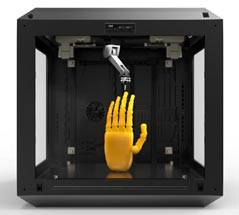3D Printing Puts the "Tech" in Biotech
- Published
- Mar 27, 2018
- Topics
- Share
The life sciences sector has experienced several significant changes that have driven innovation over the past few decades. Advances in technology have dramatically changed how life sciences utilize genetic engineering to rapidly analyze human populations, viruses and bacteria — leading to much more effective treatments. Increases in computing power have allowed researchers to model viruses and protein folds with detail never thought possible, allowing them to better understand potential drug interactions and effects prior to animal and human testing. Finally, advances in material science have led to new categories and uses of medical devices.
Areas of material science that have enormous potential are 3D printing and its cousin, bioprinting. They can generally be defined as making a physical object from a three-dimensional model by layering many thin layers of material in succession and then using such three-dimensional printing to layer living cells to create biological tissue and organs. 3D printers typically function like a standard inkjet printer, but they utilize materials such as plastics or polymers to create new objects.
History
3D printing began with industrial applications in the 1980s and 1990s and was initially focused on rapid prototyping. This let companies quickly and easily produce new tooling, dies and castings that allowed them to investigate new designs and product changes. In 2002, researchers created miniature functional kidneys by printing cells directly onto a synthetic scaffold. The industry took another major step forward in 2006 when selective laser sintering machines fused materials onto these scaffolds, which allowed for much more significant customization and higher manufacturing yields. This led to another milestone in 2008 when the first person walked using a prosthetic limb that was printed entirely without any assembly.
The Marketplace
According to 3D Printing Progress, the 3D printing industry is estimated to grow to approximately $6 billion by 2024. Prosthetics, knee and hip replacements, implants, hearing aids, tissue and medicines are expected to drive 3D-printed biotech products.
 Prosthetics are one of the major (and more obvious) choices for 3D printing. Fitting a prosthetic to an individual and his/her unique circumstances has been one of the challenges with traditional prosthetics. Additional surgery was often needed to modify implants and bones to fit a fairly standardized implant. Now, with 3D printing, it is easier to customize each implant for a specific fit and design. This has led to enhanced quality of life for many patients, particularly children. These young patients would outgrow costly prosthetics at a rapid rate; now 3G-generated prosthetics can be utilized more quickly and affordably than before.
Prosthetics are one of the major (and more obvious) choices for 3D printing. Fitting a prosthetic to an individual and his/her unique circumstances has been one of the challenges with traditional prosthetics. Additional surgery was often needed to modify implants and bones to fit a fairly standardized implant. Now, with 3D printing, it is easier to customize each implant for a specific fit and design. This has led to enhanced quality of life for many patients, particularly children. These young patients would outgrow costly prosthetics at a rapid rate; now 3G-generated prosthetics can be utilized more quickly and affordably than before.
Implants are another area with multiple applications. These can range from knee and hip replacements to dental and oral implants to bone — again, enhancing quality of life at a lower cost.
Hearing aids have become another (so far little-noticed) area for 3D printing. Each person’s ear canal is different, leading to fitting issues with mass-produced tips. According to Forbes, the majority of hearing aids are now manufactured using a 3D process. A patient can visit a doctor’s office, have his/her ear scanned with laser and digital cameras, and receive the end product — all in under a day!
Tissue, organs, bones, muscle and skin 3D printed to match samples taken from a patient in order to decrease rejection are on the drawing board and will hopefully be the norm one day.
Medicines produced via 3D printing, which can be tailored to each patient to provide a more fine-tuned drug delivery, are being researched by biotechnology companies.
Hurdles
The 3D printing industry continues to grapple with issues such as safety confidence, regulatory concerns and high expectations. And while 3D printers offer significant benefits, there are those who worry about such things as patent infringement or the production of products for nefarious purposes. Researchers will need to be vocal and thorough in conveying the efficacy of 3D bioprinting to the regulating authorities and end users. Those hurdles aside, the use of 3D and bioprinting may offer another golden age of medicine.
Business Impact
What should a CFO or someone in a similar position consider when it comes to 3D printing? A good first step is understanding your supply chain and how quickly you may need to address product changes in your marketplace. Are you rapidly developing a new product with multiple iterations, or do you have a need for an automated process to produce customized parts? A 3D printing process could help you to respond to these needs effectively and cost-efficiently. Alternatively, what if you’re looking to invest in a company’s 3D printing process? It is important to understand where that company is using its 3D printed parts, specifically related to their reliability, regulatory effect and cost.
Catalyst - Spring 2018
Contact EisnerAmper
If you have any questions, we'd like to hear from you.
Receive the latest business insights, analysis, and perspectives from EisnerAmper professionals.








